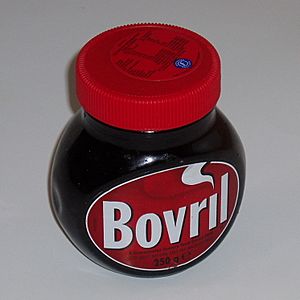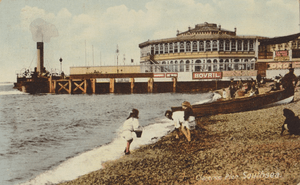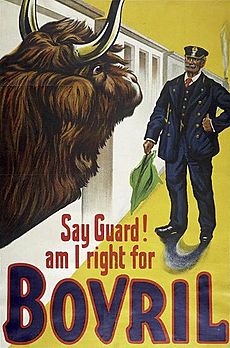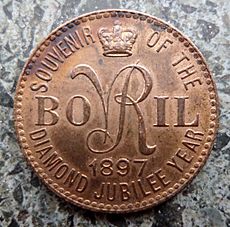Bovril facts for kids

Bovril (250 g jar)
|
|
| Inventor | John Lawson Johnston |
|---|---|
| Inception | 1889 |
| Manufacturer | Bovril Company |
| Current supplier | Unilever |
| Website | Lua error in Module:WikidataIB at line 168: attempt to index field 'wikibase' (a nil value). |
Bovril is a thick, salty paste made from meat extract. It's a bit like a yeast extract spread, such as Marmite or Vegemite. John Lawson Johnston created Bovril in the 1870s. You can find it in a special round jar, or as cubes and granules. Today, Unilever UK owns and sells Bovril.
You can mix Bovril with hot water to make a warm drink. Sometimes, people even mix it with milk. It's also used to add flavor to soups, stews, or porridge. Many people enjoy it as a spread on toast. For a short time, from 2004 to 2006, Bovril was made without beef, making it vegetarian. However, the company later decided to put beef ingredients back into the recipe.
Contents
What's in a Name?
The name "Bovril" has an interesting story. The first part, Bov-, comes from the Latin word bovīnus. This word means "about an ox" or "from a cow".
The second part, -vril, comes from a popular book written in 1871 by Edward Bulwer-Lytton. The book was called The Coming Race. In this story, there's a powerful group of people called the Vril-ya. They get their amazing powers from a special energy called "Vril". So, the name Bovril suggests that the product gives you great strength, like an ox!
A Look Back: Bovril's History
Bovril was first created in 1870 during the Franco-Prussian War. Napoleon III, the leader of France, needed a lot of beef to feed his soldiers. He ordered one million cans of beef.
John Lawson Johnston, a Scottish butcher living in Canada, was given the job. It was hard to transport and store large amounts of fresh beef. So, Johnston came up with a new product. He called it 'Johnston's Fluid Beef', which later became Bovril. This helped meet the army's needs.
By 1888, Bovril was very popular. Over 3,000 places in the UK, like pubs and grocery stores, were selling it. In 1889, the Bovril Ltd company was officially started to help the business grow even more.
Bovril in Wartime
Bovril was also important during other wars. During the Second Boer War in 1900, soldiers trapped in the Siege of Ladysmith made a similar paste from horsemeat. They called it Chevril. It was made by boiling horse or mule meat until it turned into a jelly. They drank it like tea.
Bovril also made a special dried beef for the British Army during this war. It came in a small tin. One half had dried beef, and the other half had a dried cocoa drink. Soldiers could eat the beef as it was, or mix it with water to make a beef tea.
Bovril continued to be a "war food" during World War I. It was often mentioned in stories from that time. For example, in a 1930 book, it describes Bovril being made for wounded soldiers at Mons.
When John Lawson Johnston passed away, his son, George Lawson Johnston, took over the Bovril business. He was later given the title Baron Luke in 1929.
Changes and Ownership
In 1966, Bovril launched its instant beef stock. Then, in 1971, they introduced their "King of Beef" range for stews and gravies. Over the years, the company changed hands. In 1971, James Goldsmith's Cavenham Foods bought the Bovril Company.
Today, Bovril is owned by Unilever, a large company that bought Bovril in 2001.
In 2004, Unilever changed the Bovril recipe. They removed beef ingredients to make it vegetarian. This was because more people were becoming vegetarian, and there were concerns about beef exports. However, in 2006, Unilever brought beef back into the recipe. This happened after sales increased and the bans on beef exports were lifted. Now, Unilever makes Bovril with beef extract and also a chicken version with chicken extract.
In 2020, a football club called Forest Green Rovers worked with Bovril to create a new version made from beetroot. This special Bovril is sold at their stadium, which doesn't sell meat products.
Where Else is Bovril Made?
In South Africa, Bovril is made by a company called Pioneer Foods, through its Bokomo division.
Bovril's Place in Culture

In the early 1900s, Bovril was advertised as a "superfood". Ads suggested mixing it into a tea or spreading it on toast. Some even claimed it could protect you from the influenza flu!
Bovril jars are often found by archaeologists when they dig up old sites, like at Knowles Mill in Worcestershire. This shows how common Bovril was in the past.
Bovril has become a well-known part of British culture. It's especially linked to football culture. During cold winter games, British football fans often drink hot Bovril from Thermos flasks in the stadium stands. In Scotland, where thermoses are not allowed in stadiums, fans drink it from disposable cups.
Bovril even had a very unusual advertisement in the early 1900s. It showed Pope Leo XIII sitting on his throne with a mug of Bovril. The slogan said: The Two Infallible Powers – The Pope & Bovril.
Bovril beef tea was the only hot drink available to Ernest Shackleton's team. This was when they were stuck on Elephant Island during their difficult 1914–1917 Endurance Expedition.
In the movie In Which We Serve, officers are given "Bovril rather heavily laced with sherry" to warm them up. This happens after they are rescued during the Dunkirk evacuation of the British Expeditionary Force.
British mountaineer Chris Bonington appeared in Bovril TV commercials in the 1970s and 1980s. He talked about melting snow and ice to make hot drinks during his climb of Baintha Brakk, also known as "The Ogre."
See also
 In Spanish: Bovril para niños
In Spanish: Bovril para niños
- Bonox
- Liebig's Extract of Meat
- Portable soup
- Oxo
- Bovril, Argentina
- Bovril boats




